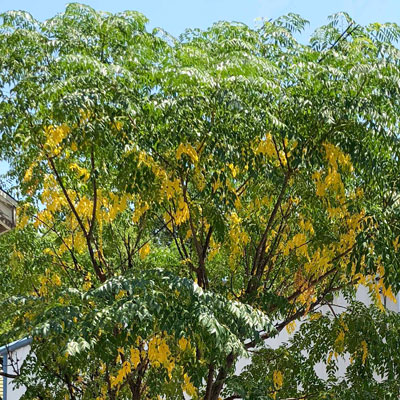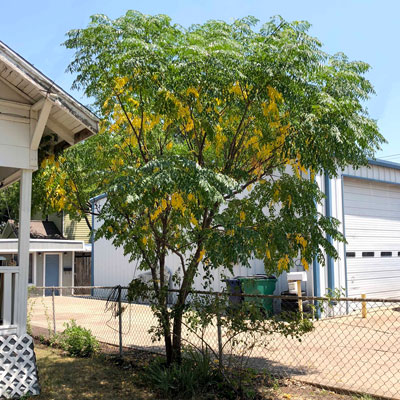Question of the Week Number 1: August 2, 2018
“Why is my shade tree dropping so many leaves? They’re turning yellow and falling like autumn.”
EVERYwhere I’ve gone the past week or two people have been asking exactly that question. Before I can type up the answer, someone else is posting the next photo and query.

Chinaberry’s leaves are quickly turning yellow from the bottom, interior of the tree outward and upward.
This is all about heat and drought. Trees produce their leaf canopies in the spring. Conditions back then were cool, and for the most part, things were moist – at least, a lot more moist than they are right now.
So then our trees ran into this wall called “summer.” Hot, dry summer. Summers are usually hot and dry here in Texas, but this one has been something special.
So picture yourself hiking up a Texas hillside in summer. You dress for spring weather when you leave early in the morning, but before you arrive at the top, it’s 105 and unbearingly sunny. Odds are you’re going to start shedding some of those clothes. Jacket, sweatpants, long-sleeved shirt – you leave them all behind.

You can see the pattern of yellowing on the chinaberry tree as it struggles its way through an unirrigated summer.
Trees do their own version of that very same thing. They start shedding their leaves to lighten the load on their root systems and conducting tissues. For the most part it’s older, lower leaves that get dropped off first, but it progresses up from the inside of the canopy until there’s a pile of leaves on the ground. Almost like November, yet it’s still early August.
Large-leafed, fast-growing trees are most likely to suffer this leaf drop, but in extreme years like this one, even natives like cedar elms, bur oaks and pecans will get into the act.
Should you worry? What can you do?
If you’re dealing with mature, established trees that are 8 or 10 years old or older, your trees will probably be fine. All you’ll need to do is ramp up the watering. You can do so either by running the sprinklers a little longer or by laying a soaker hose around the outer drip lines of your trees and letting it run for 12 or 18 hours each week. Then the following week, move the soaker hose to a slightly different configuration and run it again. Your trees will survive the dry spell quite handsomely.
If you have new trees and if they have turned yellow and brown, that’s a much worse sign. Hopefully there’s still plenty of green growth in place. It’s imperative that you soak new trees deeply by hand (hose with a water breaker or bubbler attached) every 2-3 days during their first couple of summers.
